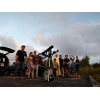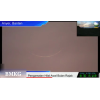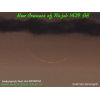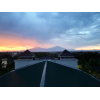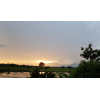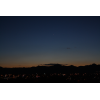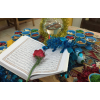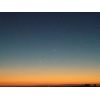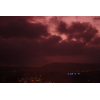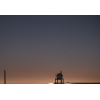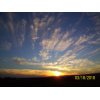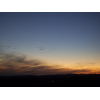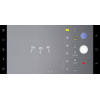Visibility of Rajab Crescent 1439 AH
- When to Observe Rajab Waxing (NEW) Crescent ?
- Rajab Waxing (NEW) Crescent Observation Results
- The OFFICIAL First Day in Different Countries
- When to Observe Jumadal Al-Aakherah Waning (OLD) Crescent ?
- Jumadal Al-Aakherah Waning (OLD) Crescent Observation Results
When to Observe Rajab Waxing (NEW) Crescent ?
The geocentric conjunction (Geocentric New Moon) will occur Inshalla on (Saturday 17 March 2018) at 13:12 UT.
Sighting the new crescent on (Saturday 17 March 2018) and (Sunday 18 March 2018) is shown in the below graphs using the program Accurate Times by Mohammad Odeh according to Odeh criterion. Where:-
- It is impossible to see the crescent from the areas located under the red color. Because either the Moon on this day sets before the Sunset and/or the topocentric conjunction occurs after the Sunset.
- The crescent is expected to be seen by optical aid only from the areas located under the blue color.
- The crescent is expected to be seen by optical aid from the areas located under the magenta color. In these areas the crescent could be seen by naked eye if the atmospheric conditions are superb and the observer is experienced.
- The crescent is expected to be easily visible by naked eye from the areas located under the green color.
- The crescent cannot be seen from uncolored areas, even though the Moon sets in these locations after the Sunset and the topocentric conjunction occurs before the Sunset, but the Moon is not sufficiently illuminated in order to be seen as crescent even by optical aid.
- Kindly notice that the below graph shows the possibility of seeing the crescent from areas between 60 degrees north of Equator down to 60 degrees south of Equator.
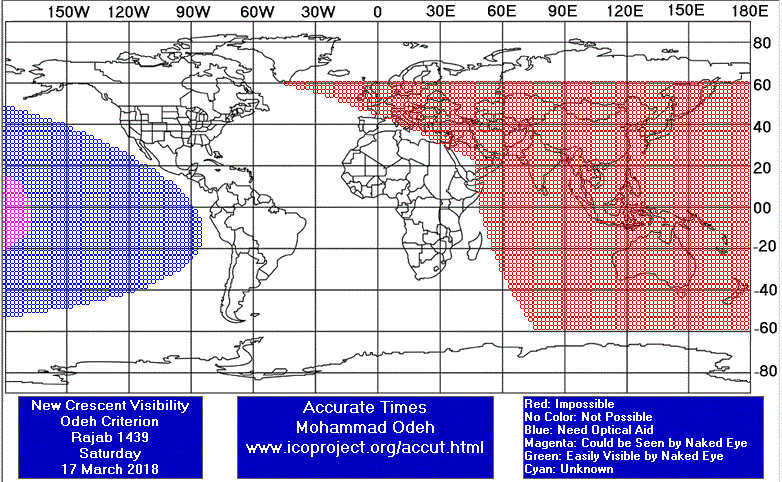
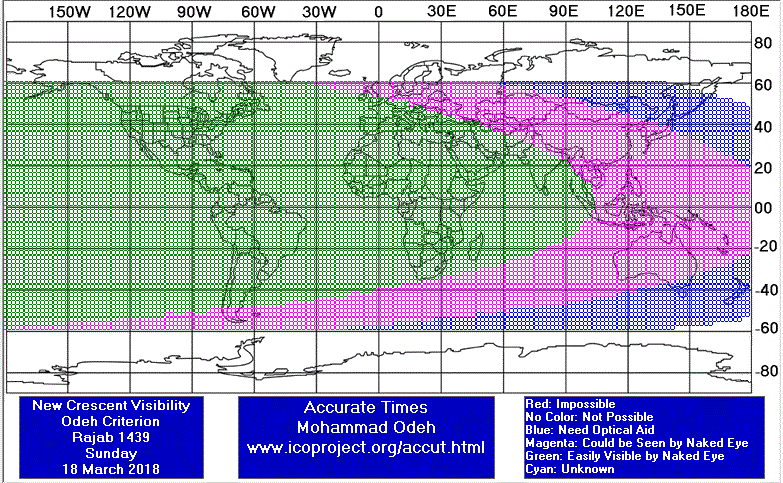
According to the Universal Hejric Calendar (UHC), which is based on the calculated crescent visibility, the start of this month in the Eastern Region will be on Monday 19 March 2018 and in the Western Region will be on Monday 19 March 2018. Kindly notice that the UHC is a pre-calculated calendar, which adopts a certain criterion to start the new Hejric month. Your country/organization might adopt different criterion to start the new Hejric month. So it is highly advised to read the UHC website before giving any judgment.
- Results of seeing the crescent, and the first day of the month in different countries will be added here Inshalla as we receive the reports from ICOP's members. If you wish to be a member in ICOP, or to know more about it, kindly click here.
Rajab Waxing (NEW) Crescent Observation Results
Sat 17 March 2018
Nigeria
Mr. Qamarudeen Muhammad said: "Both National Moonsighting committee, technical members and Sultanate Advisory Council for Religious Affairs with joint membership participation try to observe new crescent of Rajaab tonight Saturday 17,March 2018 at the outskirts of Sokoto city, the crescent was not visible."
Sun 18 March 2018
Brunei Darussalam
Mr. Hazarry Haji Ali Ahmad said: "The western sky was very cloudy. The 22.5 hour old cresent was visible where there were clouds break, at 23 minutes after sunset. The moonsighting observation was organised by members of the Astronomical Society of Brunei Darussalam at Agok Hill in Tutong."
Indonesia
Mr. AR Sugeng Riyadi said: "Bismillaah... The new crescent of Rajab 1439 AH was not seen on Sunday 18th of March 2018 from Rowasiya Observatory at Klaten Central Java by myself and Assalaam Observatory at Sukoharjo Central Java by my students, the sky was rainy. The hilal was sighted from Bandung by mr. Ahmad I. Adjie, from Cibeas Pelabuhanratu West Java by mr. Ismail Fahmi and from Anyer Banten by BMKG Team. The 1st of Rajab 1439 AH in Indonesia will start on Monday, March 19th, 2018. Alhamdulillaah..."
Iran
Mr. Hossein Janghorbani said: "In the name of God Happy new Years (1397 - In accordance with Iran's official calendar) Rajab Crescent Observation Report The Astronomy and Geophysics Center of Shahreza – The Crescent Association of Shahreza Report by: Hossein Janghorbani (Najmosepehr-Sadrolmonajjemin) – Manager of Shahreza Crescent Association and Red Crescent’s Astronomy and Geophysics Center Date: Sunday, 03/18/2018 Location: Damzad foothills in the East of Shahreza (latitude: 32 00 N, longitude: 51 52 E, elevation: 1825m from sea level, time zone: +3.5 GMT) Equipments: Two sets of 15*70 binoculars, One sets of 20*60 binoculars, One sets of 7*50 binoculars, One compass. Atmospheric condition: hazy. Horizon obstacles: 2° Apparent sunset: 18:02 Results: Moon crescent was seen by 15*70 binoculars by Hossein Janghorbani at 18:19, for the first time. Other group members observed crescent by binoculars subsequently. Crescent observed by Mohadeseh Alinezhad and Shahnaz Soroori and Reza Janghorbani at 18:27 by naked eye. Other group members observed crescent by naked eye. Observers: 1.Dr. Mehrdad Moslehi 2. Abdolreza Gholami 3. MohammadMahdi Jambakhsh 4. Saer Aliabedi 5. Hatef Rahmati 6.Sayed Farzad Alavi 7. Sayed Moslem Rezvani 8. Reza Janghorbani 9. Ali Janghorbani 10. Hossein Janghorbani 11. Elham Rajaee 12. Mahtab Bahrami 13. Toktam Aliabedi 14. Shahideh Torabi 15. Nasrin Kaviani 16. Zohreh Karimpoor 17. Shahnaz Soroori 18. Fatemeh Hadad 19. Mohadeseh Alinezhad 20. Naeemehsadat Saniee 21. Ziba Hafar 22. Maryam Shahcheraghi 23. Zinat Ghermezi 24. Parisa Ghadimi 25. Ezat Nazariat 26. Mohammad Javad Nikeghbal 27. Zahra Falahi "
Morocco
Dr. Hassan Talibi said: "السلام عليكم تتميما للتقرير أخبركم أن رؤية الهلال ثبتت ثبوتا شرعي كما أعلنت وزارة الأوقاف كما أن بعض الزملاء المهتمين أثبتوا رؤيته خصوصا في الأقاليم الجنوبية وأذكرمنهم الأخ عبد اللطيف بندحو الذي رصد الهلال وصوره كما تجدون في الصورة المرفقة."
Mr. Abdessamad Doukkane said: "قامت جمعية المبادرة المغربية للعلوم والفكر بمراقبة الهلال مع مندوبية الأوقاف والشؤون الإسلامية بالناضور. وقد تعذرت الرؤية بسبب الرياح القوية والجو الغائم. وتؤكد الجمعية أن الرؤية ممكنة ،في انتظار إعلان الوزارة أن يوم غد أول رجب"
Saudi Arabia
Mr. Turki Alamri said: "i did not try to image the new crescent during daylight i started my observation after sunset with a very hazy sky i managed to see it with two of my neighbors and i took an image of the new crescent with Venus and Mercury ."
United Kingdom
Mr. Mohammad Baig said: "It was not only totally cloudy but also snowing"
United States
Dr. Javad Torabinejad said: "A friend of mine and I arrived at our sighting location a few minutes before sunset (sunset: 7:32 EDT pm). The western horizon was partly cloudy. Using pairs of binoculars (7X50 and 10X50), we started scanning the horizon. The first binocular sighting was at 7:24 pm followed by naked eye sighting. Venus was a great guide to locate the moon. The horns were at 2:30 and 7:30 O'clock (2:30;5:00;7:30). The first binuclear sighting of Mercury was at 7:45 pm followed by it's naked eye sighting at 7:56 pm. We left the site prior to moonset (moonset: 8:49 pm). "
Dr. Javad Torabinejad said: "Using a pair of binoculars, I sighted the crescent. I did not try naked eye sighting since I could not locate the moon again when I resumed looking for the crescent after checking the time."
The OFFICIAL First Day in Different Countries
Mon 19 March 2018
1 . Egypt
2 . Indonesia
3 . Iran
4 . Jordan
5 . Libya
6 . Morocco
7 . Oman
8 . Palestine
9 . United Arab Emirates
10 . United Kingdom
When to Observe Jumadal Al-Aakherah Waning (OLD) Crescent ?
The geocentric conjunction (Geocentric New Moon) will occur Inshalla on (Saturday 17 March 2018) at 13:12 UT.
Sighting the OLD crescent on (Saturday 17 March 2018) and (Friday 16 March 2018) is shown in the below graphs using the program Accurate Times by Mohammad Odeh according to Odeh criterion. Where:-
- It is impossible to see the OLD crescent from the areas located under the red color. Because either the Moon on this day rises after the Sunrise and/or the topocentric conjunction occurs before the Sunrise.
- The crescent is expected to be seen by optical aid only from the areas located under the blue color.
- The crescent is expected to be seen by optical aid from the areas located under the magenta color. In these areas the crescent could be seen by naked eye if the atmospheric conditions are superb and the observer is experienced.
- The crescent is expected to be easily visible by naked eye from the areas located under the green color.
- The crescent cannot be seen from uncolored areas, even though the Moon rises in these locations before the Sunrise and the topocentric conjunction occurs after the Sunrise, but the Moon is not sufficiently illuminated in order to be seen as crescent even by optical aid.
- Kindly notice that the below graph shows the possibility of seeing the crescent from areas between 60 degrees north of Equator down to 60 degrees south of Equator.
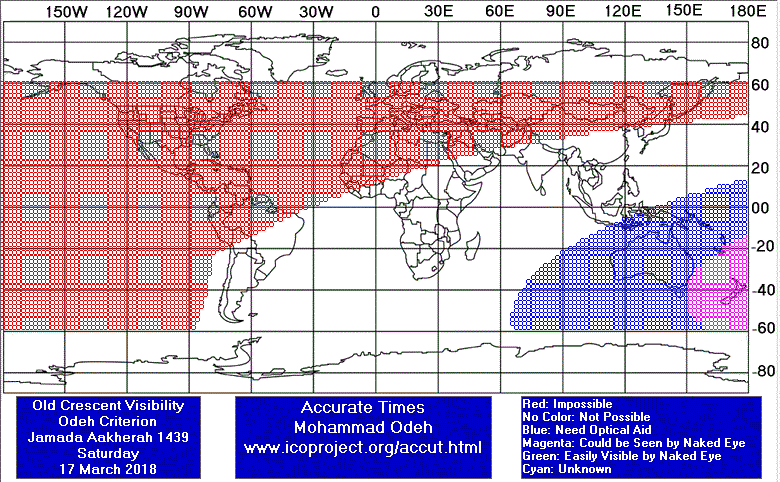
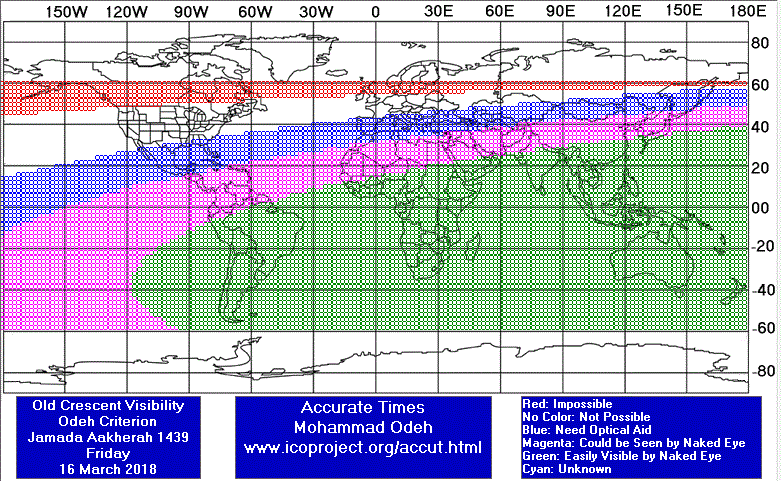
Jumadal Al-Aakherah Waning (OLD) Crescent Observation Results
Fri 16 March 2018
Indonesia
Mr. AR Sugeng Riyadi said: "The waning crescent of Jumadal Akhirah 1439 AH was sighted on Friday, 16th of March 2018 after sunrise from Rowasiya Observatory at Bendo Ketitang Juwiring Klaten Central Java Indonesia. The sky was clear and the moon was captured by my gadget that pluged into telescope by mobile adapter."
Mr. AR Sugeng Riyadi said: "The old crescent of Jumadal Akhirah 1439 AH was not seen on Friday, 16th of March 2018 from Rowasiya Observatory at Bendo Ketitang Juwiring Klaten Central Java Indonesia, the sky was cloudy. The old crescent was seen by mr. Ahmad Junaidi from Ponorogo East Java."
